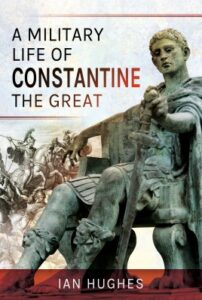Ian Hughes
A Military Life of Constantine the Great
(Pen & Sword, 2021), 304 pp. $42.95

Ian Hughes is a very prolific author, who produced a significant number of books in the last few years. All of them, similar to the current one, concentrate on the Late Roman Empire. This book is supposed to complete Pen & Sword’s endeavour to create a comprehensive library of Roman military history, with a book dedicated to each period and Emperor or important military leader. Some of the titles dealing with the Late Empire, which are mostly written by Hughes and Ilka Syvänne (who covers the same periods) often overlap in their choice of subject matter. On the other hand, the current book, which deals with Constantine’s reign, actually fills a gap in Ilka Syvänne’s works. As will be discussed, Hughes excels in areas where Syvänne lacks, and vice versa.
The majority of the problems in Hughes’ book are concentrated in the introduction and the first three chapters. The most significant problem is the different explanations for the formation and structure of the Roman military at the time. The first occurrence can be found on pages vii-ix. This very elementary and short explanation is far too short, inaccurate and its inclusion in the book as a whole can be seen as a conundrum. This is because there is a second explanation about the Roman army on pages 7-10, which is once again inaccurate, with most of the mistakes created in the attempt to produce such a short introduction. Even this second explanation of the Roman army, its existence and role, is an enigma as there is a much longer, more detailed introduction later on (pp. 19-39). The repetitive nature of the first part of the book is not the main problem, but the content of these explanations certainly is. The different introductions contradict themselves and in all three of them, there are mistakes. For example, on pages 26-30, Hughes speaks about the terms Comitatus and Comitatenses as the same thing, which is incorrect. Yet finally, on page 39 he explains correctly that Comitatus are bodyguards and Comitatenses are field armies. The problem with these terms continues, as until page 200, he uses only the term Comitatus, and mentions the term “field armies”, or Comitatenses, only once. This is sensible as he wrote that the Comitatenses were possibly created in 325 A.D. (p. 207). However, a couple of pages before (pp. 205-206), he discusses Licinius’ Comitatenses, which is in stark contrast to his other claims and the terminology he used in the previous 150 pages. It is impossible for there to be Comitatenses in Licinius’ army that was defeated in 324 A.D., as Hughes has shown that we find them mentioned only from 325 A.D., where he himself suggests that this was when they were first formed.
This is not the first, nor the last, time that Hughes mixes things up, as for example, he even confuses Emperor Maxentius for Emperor Maximian on pages 13-15. Furthermore, Hughes often states throughout the book that “many historians say…”, or “there are some saying…” and so on and so forth, without providing the names of the scholars in the text or footnotes referring to these statements (for example, on pp. 9, 201-204, 207, 212, 220-222, 246). Mistakes of this sort would not be found in Ilka Syvänne’s books. On the other hand, Hughes does several things better than Syvänne. Firstly, he uses endnotes and not in-text citations, which allows the book to flow. Secondly, Hughes has a better talent for writing and storytelling, making the book much more accessible and fun to read. Hughes is at his best on pages 50-200. Thirdly, Hughes deals better with numbers and army size than Syvänne, as he actually doubts and discusses the numbers fully. He offers good explanations and takes into account the terrain, field communication and logistics, things that Syvänne usually disregards. In addition, Hughes not only diminishes the size of ancient armies, but he also increases their size when necessary and explains why the sources are wrong. For example, he explains that Constantine’s army in the campaign of 316 A.D. must have been larger than the 20,000 strong that the sources state, as such an army would be too small and illogical when considering what was available to him and what he tried to achieve (p. 158). On the other hand, he was most probably mistaken on page 161 when he wrote “An army of c.30,000 men was probably at the extreme end of the size of army capable of being controlled using Roman army organization.” This is because we have numerous testimonies from antiquity for much larger armies. In my opinion, the maximum size should be considered as around 80,000 men. This is well below Syvänne’s ridiculous claim that at the battle of the Catalaunian Plains, each army had around 400,000 men (See my review of Ilkka Syvänne, Military History of Late Rome 425–457- https://deremilitari.org/2021/02/ilkka-syvanne-military-history-of-late-rome-425-457-haggai-olshanetsky/).
All in all, Hughes’ book has its merits and its problems. If a reader is well acquainted with the Late Roman army and its terminology, they can skip the first 50 pages and mainly focus on reading pages 50-200, which are a much more solid and accessible explanation of the military events during Constantine’s life than those given in other places. However, for anyone else, I ought to recommend not to buy the book and hope, like I am hoping, that Hughes would provide a corrected edition of the book in the future, which would amend the mistakes the current one has. In such a case, I would be the first to buy the new edition and to highly recommend this book.
Haggai Olshanetsky
Bar Ilan University
